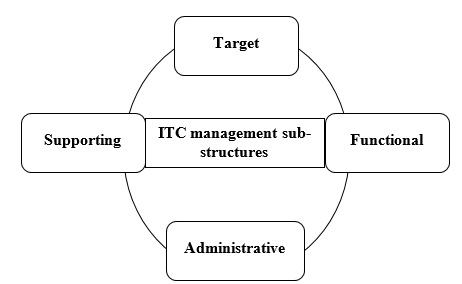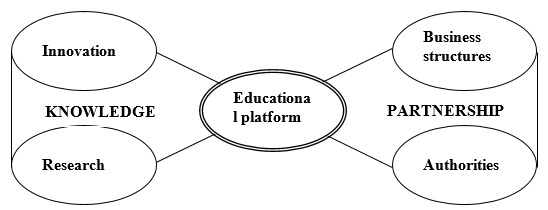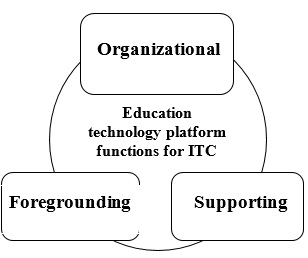Education Technology Platform As The Structural Element Of International Transport Corridor Management
Abstract
The paper outlines formation of an international transport corridor and its functioning in integrative and global context that require new standards for managing global systems. The study defines what an international transport corridor (ITC) and education technology platform are. Furthermore, the article amply describes ITC management system and characterizes its subsystems. The education technology platform is presented as the structural element of the supporting subsystem of ITC management. Considering that ITC comprises such external factors as legal landscape, socioeconomic background and investment climate, it is characterized as an ecosystem. The authors determine functions of the education technology platform within ITC management system and describe the tasks to be accomplished in the platform framework at ITC formation and functioning stages. It is stated that the expansion of international cooperation of science and education is one of the fundamental factor for managing ITCs effectively which can further ensure stable economic and logistic development, higher quality of education and further affect ITC managing staff. The paper represents the platform as a cooperation forum for all interested parties (universities, science organizations, manufacturing companies, authorities, etc.) to solve strategic tasks of scientific and technological development for Russian economy, among which is the development of international transport links.
Keywords: Ecosystemeducation technology platformInternational transport corridor (ITC)management systemtransportuniversity
Introduction
Digitalization does not confine itself to optimizing and demonstrating transforming effect on all life aspects. New common interests between various business structures, which appeared as the result of a reform, are gradually expanding, thus, creating new niches and changing world’s economy.
Satisfying businessmen’s digital needs in the globalized society makes transportation and logistics processes more complicated. It facilitates service quality and logistics infrastructure as well as creates new transport corridors suitable for digital economy.
In order to reach these goals it is necessary to implement the systems approach for managing transport corridors on each stage of their formation and functioning. In doing so, the new system has to take into consideration specific features of the modern digital economy and contribute to the formation of an effective mechanism of legal support for the management of transport systems, which meets the innovative needs of entrepreneurs (Dobrosotskaya & Martynov, 2018).
Problem Statement
On the basis of historical institutional unity of science and education Russian universities, staying independent to more or less extent, are nowadays getting involved in development of a knowledge-based economy.
The importance of educational platform as a natural monopolist producing new knowledge and technical solutions increases as it expands from the knowledge- and technically-based economy influence to interdisciplinary and humanitarian strategically significant sectors. Therefore, creating a new system of the international transportation management in digital environment cannot be managed without prime educational technologies as the structural element of this system.
Research Questions
The research deals with the following questions:
What is an international transport corridor?
What is the international transportation management system (ITMS)?
What elements does ITMS consist of?
What is the role of education technology platform in ITMS?
What is the use of education technology platform in developing international transport corridors?
What is the providing (supporting) role of education technology platform for international transport corridors?
Purpose of the Study
Expanding international science and educational contacts is currently one of the fundamental aspect of the ITMS that can ensure stable economics and logistics, professional management staff and improve the quality of education, operationally devise complex methodological approaches to the TMS legal support to sustain business compatibility at the international level (Dobrosotskaya, 2018).
In connection with this, federal authorities are responsible for setting up educational platforms on the basis of the existing transport corridor. These problems should be sorted out by improving and implementing manufacturing and technical transportation projects; statutory instruments which will enable effective corridor operation. At the same time, the University cannot solve these problems on its own. According to Peskov, there is no model of a modern University adequate to the challenges of the digital economy (Kuzminov & Peskov, 2017). The effectiveness of a country's scientific community now depends on its ability to act globally (Marginson, 2014).
Education technology platform is a communicative tool aimed at intensifying efforts to create perspective commercial technologies, new products, educational services and attract additional resources. This is a platform for conducting research and studies involving all interested parties (business, science, state, civil society), upgrading legislation and tools of the intellectual management (Martynov, 2017) related to scientific and technological innovative development.
Interaction of various interested parties (universities, science organizations, manufacturing companies, authorities and others) is unfolding on the basis of the education technology platform, thus, making it possible to meet strategic objectives focused on scientific and technological development of Russian economics sectors to which the educational platform is related. The members of the educational platform coordinate and cooperate with each other at the pre-competitory stage of applied research and development. Besides, “joint institutions contribute to the competitiveness of educational services of the participating countries, and also serve as an effective tool for promoting national culture, language, values and lifestyles” (Medianik, 2017, p. 18).
The purpose of the study is to explore education technology platform as the structural element of international transportation management, to define its role and functions at all transport corridor operational stages.
Research Methods
The following methods were used to achieve study purposes, meet set takes and challenges:
theoretical methods of analysis;
systemic-structural method;
statistical analysis;
synthesis and abstract methods.
Findings
Here is the detailed study of issues defined above.
What is an international transport corridor?
Experts of the Economic Commission for Europe define an international transport corridor (ITC) as a part of national or international transport system that maintains cargo and passenger transportation between separate geographical areas; it comprises rolling stock, stationary devices for all corridor transport modes and the whole complex of technological, structural and law terms for handling transportation (UNECE, 2018).
That is to say, ITC embodies not just highways, railways, sea and air lanes, machinery and vehicles, buildings and constructions for cargo and passengers logistics. It also includes all supporting infrastructure and such environmental factors as legal landscape, socioeconomic background, investment climate which characterize ITC as an ecosystem.
Thus, the complex structure of ITS caused by its divergent elements and influenced by unstable globalization processes determines the new complex management approach. The latter should ensure stable development of ITS in constantly changing economic and political environment, therefore, the livability of ITS depends directly on management effectiveness.
What is the international transportation management system (ITMS)?
ITC complexity establishes rigid rules for the management structure. ITMS should be aimed at supporting transportation quality according to set standards and expanding corridor infrastructure. This requires constant efforts on a range of activities.
The diversification of management tasks characterizes ITMS as a purposeful complex structure for effective use of the transport corridor. This system takes into consideration and forecasts all external and internal factors which impact on a controlled segment of the transport ecosystem.
Having said that, it is necessary to conduct a structural analysis of ITC management to clarify the study issue.
What elements does ITMS consist of?
It is reasonable to outline several sub-structures based on ITC system tasks: target, functional, administrative and supporting, shown in Figure

Each sub-structure is aimed at solving the following tasks:
Target substructure:
improving transport services quality;
attracting investors to develop ITC; expanding ITC infrastructure;
successful integration of ITC into ecological, institutional and social environment.
Administrative substructure:
improving effectiveness of ITC staff: forwarders, logistics, procurement managers, etc.
formulating psychological methodology for managing staff;
implementing management policy in the absence of monopoly on controlling ITC objects.
Supporting substructure:
monitoring, developing and managing digital technologies for ITC upgrading (e.g. block chain);
making recommendations for optimized investment distribution among ITC members;
educational and technological development of ITC and its specialists;
managing legal resources.
Functional substructure:
contribution to ITC operational processes (marketing);planning of ITC development;
monitoring and handling ITC development;
prompt feedback to ITC progress and making situational recommendations to re-address resources.
Target and administrative substructures, as we see it, are advisable to consider as two main focal points: the ability to change outer circumstances (target) and transformation of inner structure – making the staff more effective (administrative), whereas functional and supporting substructures represent strategic and operational resources management, monitoring its results. All things considered, the first two substructures are related to dynamic development (inner and outer), the other ones ensure ITC internal balance.
What is the role of education technology platform in ITMS?
As noted above, education technology platform is the structural element of ITC supporting substructure. To evaluate its specific role in transport ecosystem it is necessary to define this structural element and clarify its significance for public relations system.
Thus, an education technology platform is, to our mind, the way of organizing interaction between various participants (business structures, authorities, independent experts) for solving highly complicated socially meaningful problems within an educational institution, educational unions or nets. Educational unions are notably more essential for universities in particular due to increasing resources, getting control over certain sectors and rising creative potential in competitive and rapidly changing higher education environment (Stensaker, 2018).
Social significance of education technology platforms is being unfolded by the “knowledge triangle” – education, research and innovation as well as by the traditional partnership model represented as the “triple spiral” – universities, business and authorities (Raunio, Nordling, Kautonen, & Räsänen, 2018) shown in Figure

What is the use of education technology platform in developing international transport corridors?
In our opinion, the following tasks should be accomplished while creating a new international transport corridor:
searching for the best geographical location meeting economical needs of all interested parties;
monitoring of all infrastructural, legal and ecological capacities of the future route;
defining the whole range of tasks and staff competence, necessary for each stage of designed ITC with proceeding differentiation by job descriptions.
Clearly, only the last point strictly depends on education technology platform participants’ competence. However, interactive character of the forum for various entities to find ways of solving complex tasks is optimal for all aforementioned issues. All things considered, it is worth to underline organizational role of the education technology platform as the structural element of ITMS.
What is the providing (supporting) role of education technology platform for international transport corridors?
Supporting role of education technology platform is to foreground staff competence, involved in ITC processes; to develop a strategy how to provide ITC with qualified employees, educational and innovative technologies. Implementing these functions facilitates high quality of transport and logistic services within ITC during its whole “life cycle”.
Moreover, systematic monitoring of ITC effectiveness and demand is significant to mention in order to transform it in time and adapt to changing socio-economic needs of the interested parties. This task also seems to be accomplished on the basis of the education technology platform.
Conclusion
Taking everything into account, it is importantly to state that the educational technology platform plays the key role in ITC formation and functioning. Being the structural element of the supporting management substructure, it ensures great potential for sustaining high level of ITC effectiveness and accomplishes the whole range of tasks on corridor formation and functioning stages, which is shown in Figure

Thus, the education technology platform can be characterized as one of the essential elements of the modern transport ecosystem.
References
- Dobrosotskaya, S. (2018). Collisions of legal support for transportation management systems in the context of digital region development. Intellectual resources - regional development, 1, 77-81. Retrieved August 21, 2018, from https://elibrary.ru/item.asp?id=35377069.
- Dobrosotskaya, S., & Martynov, B. (2018). Current problems of transport management legal support in the frame of regional economy digitalization. Bulletin of economics, law and sociology, 2, pp. 75-78. Retrieved August 21, 2018, from https://elibrary.ru/item.asp?id=35323014.
- Kuzminov, Ya., & Peskov, D. (2017). Discussion “What Tomorrow Holds for Universities”. The education, 3, 202-231.
- Marginson, S. (2014). Russian science and higher education in a more global era. The education, 4, 8-35.
- Martynov, B. (2017). Prospects for the use of intelligent management tools in the development of digitalization of the international transport corridors of EurAsEC countries. Science and technology of the XXI century: opportunities and risks, 1, 133-138. Retrieved August 21, 2018, from https://elibrary.ru/item.asp?id=30578009.
- Medianik, E. (2017). Joint Universities as a Tool for Promoting the National Interests of Russia and China. International Organisations Research Journal, 12(1), 7–23.
- Raunio, M., Nordling, N., Kautonen, M., & Rasanen, P. (2018). Open Innovation Platforms as a Knowledge Triangle Policy Tool - Evidence from Finland. Foresight and STI Governance, 12(2), 62-76.
- Stensaker, B. (2018). University Alliances: Enhancing Control, Capacity, and Creativity in Dynamic Environments. The Education, 1, 132-153.
- UNECE. (2018). TransporT. Retrieved September 25, 2018, from http://www.unece.org/trans/welcome.htm.l
Copyright information

This work is licensed under a Creative Commons Attribution-NonCommercial-NoDerivatives 4.0 International License.
About this article
Publication Date
02 April 2019
Article Doi
eBook ISBN
978-1-80296-058-7
Publisher
Future Academy
Volume
59
Print ISBN (optional)
-
Edition Number
1st Edition
Pages
1-1083
Subjects
Business, innovation, science, technology, society, organizational theory,organizational behaviour
Cite this article as:
Martynov, B., & Dobrosotskaya, S. (2019). Education Technology Platform As The Structural Element Of International Transport Corridor Management. In V. A. Trifonov (Ed.), Contemporary Issues of Economic Development of Russia: Challenges and Opportunities, vol 59. European Proceedings of Social and Behavioural Sciences (pp. 520-527). Future Academy. https://doi.org/10.15405/epsbs.2019.04.56

